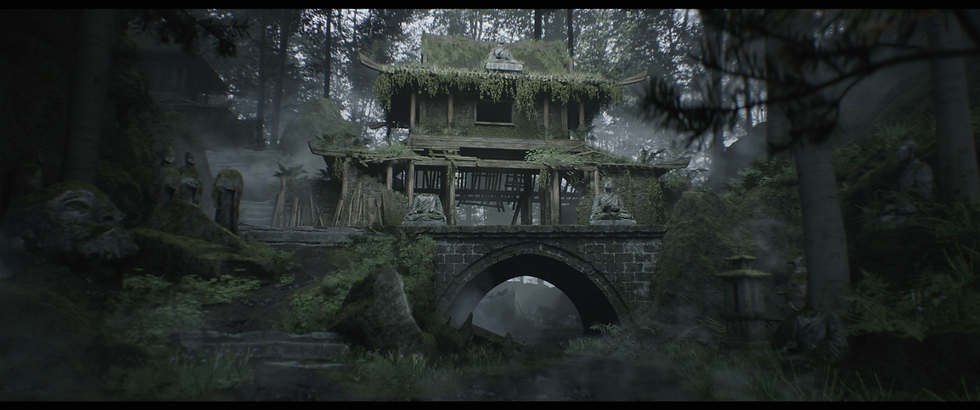Building Environment Art Skills to Kickstart Your Career: Insights from Alex Beddows
- Sierra Division

- Sep 23
- 4 min read

Alex Beddows is an Expert Environment Artist at That's No Moon, and instructor at Sierra Division Academy where he teaches Crafting Environments: Career Kickstarter.
With over a decade of experience in the games industry and mentoring artists, Alex has gathered valuable insights and best practices for juniors looking to break into the field.
In this interview, Alex shares how he got started in the industry, what he wished he knew starting out, and the essential skills every junior environment artist should know to be able to stand out to recruiters.
Are you self-taught or did you go the traditional route to learn Environment Art?
It’s funny—none of the universities I applied to accepted me. At the time, I was juggling full-time rugby with trying to develop as an artist, which meant I just wasn’t at the right level. So instead, I became “self-taught,” learning through talks, tutorials, and the communities I found online. Most of my growth came from trial and error—project after project, each one an opportunity to pick up a new skill or workflow. It was definitely the hard route, but it’s what got me to where I am today.
What was the transition like from studying to landing your first role? What do you wish you knew then?
When I first started in the industry, I put far too much pressure on myself and became overly focused on being perfect. The reality is that every studio has its own workflows and nuances, which makes it impossible to know everything from the start. That never really changes—even as a senior, you have to stay open and accept that you won’t have all the answers as you adapt to each studio’s quirks. Looking back, I wish I hadn’t placed industry artists on such a pedestal. At the end of the day, people are human: they don’t know everything, they make mistakes, and that’s completely normal. By holding them to impossible standards, I ended up placing the same unrealistic expectations on myself.

What kind of resources helped you improve as an Environment Artist when you were starting out your career?
One of the greatest resources for me was Discord communities—specifically the DiNusty community. In many ways, Discord became the new Polycount. While Polycount is still active and incredibly useful, I never engaged with it much. DiNusty, run by Jeremy Estrellado, was where things really clicked for me. Early on, Jeremy gave me a portfolio review that completely changed my trajectory. That feedback set me on the right path and ultimately led me into the industry. Looking back, all it really took was the right piece of guidance from an industry artist to help me see the way forward—and the rest is history.
Insider Tip: Join the Sierra Division Discord to connect with other artists and get feedback on your work.

What common gaps do you see in aspiring environment artists?
The two biggest issues I notice are: separating hard skills from workflows, and how artists approach learning. The first is that many artists focus on picking up cool, interesting skills, but don’t spend enough time understanding how those skills fit into a larger workflow. As a result, they often create projects that feel like a collection of disconnected techniques rather than a cohesive pipeline. This not only makes the work harder to produce, but also usually results in lower-quality visuals.
The second issue is learning itself. Almost every student I teach tries to learn five or six new things in a single project. Instead of taking small, steady steps forward, they attempt one massive leap. From my own experience of making that same mistake, I can say it usually leads to burnout, frustration, and lower-quality art.
Which core skills do you think aspiring artists need to focus on early in their careers?
Building on my previous point, what I really want to see in a scene is forethought and clear execution of a pipeline and workflow. That demonstrates planning and a holistic understanding of how to create art. I also look for the ability to analyze an image and break it down into a potential workflow, even if only verbally. This shows that the artist recognizes there are multiple ways to solve a single problem, and that they can not only choose an approach but also explain the reasoning behind their decision.


Project by Frederieke Wagner, former mentee of Alex Beddows.
We noticed you give a ton of feedback to your students. What do students need to hear the most?
I love giving feedback. When you’re working on your own project, it’s often hard to see the forest for the trees. Having someone help refocus you can push a scene so much further. It’s also easy to get caught up fixating on a single element, like a cool material or prop, instead of considering the bigger picture. For me, the most rewarding part is pushing an artist’s limits—when they think a piece is finished, but you help them realize they’ve got another 15% in them. Watching them raise the bar for themselves is incredibly fulfilling.

When you look at student work, what qualities stand out as signs that someone is ready for the industry?
I think it’s a combination of multiple factors. A strong piece of art is the bare minimum, but what really sets someone apart is their workflow and their ability to articulate why they chose it. When done well, this leads to a cohesive scene where the artist can confidently discuss their process and justify every element in detail.
Get more great tips from Alex
Enroll today in Crafting Environment: Career Kickstarter to learn directly from Alex and step-up your game.



Comments